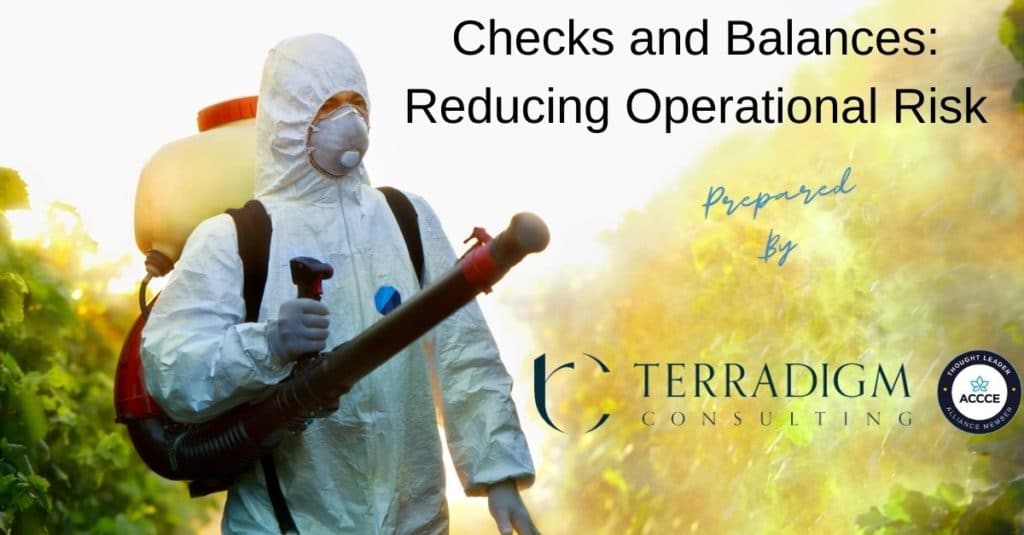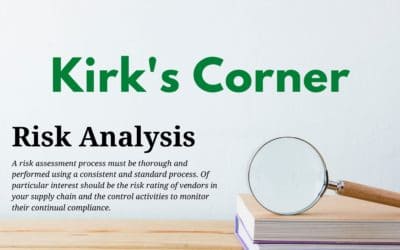
Year over year, the cannabis industry continues to evolve into a more dynamic and increasingly competitive marketplace. Operators must not only manage the day-to-day challenges unique to the industry, but they must also find ways to improve performance while reducing costs if they wish to remain competitive. While profitability and market share are the ultimate goal, maintaining compliance in an ever-changing regulatory environment puts additional pressure on companies looking to carve out their piece of the pie. Unfortunately, the pursuit of profits and the desire for a competitive advantage can sometimes lead to hasty decisions that result in unnecessary operational risk.
Operational risk is the exposure to legal penalties, financial forfeiture, and material loss a company faces if it chooses inappropriate business decisions. Operational risk comes in many different forms depending on the company’s business model but typically pertains to quality, workplace safety, consumer health and safety, compliance, or a combination thereof. Due to the technical aspects of growing, processing, and manufacturing cannabis products, the size of operations, and the pace at which companies are expanding, operational risk is a legitimate concern for every executive in the legal sector. The good news is that with the proper planning, processes, and systems in place, managers and executives can significantly reduce the operational risk associated with their business.
Decision Making
It’s safe to say that most cannabis operators want to play by the rules, avoid legal and financial setbacks, and maintain positive relations with internal and external stakeholders. Companies even set up entire departments for maintaining quality and compliance. However, cannabis is big business, which means the financial implications of each decision amplify the importance of every decision. It’s easy to make an ethical decision in a hypothetical scenario. It’s entirely different when the hypothetical scenario becomes real, and the stakes are in the hundreds of thousands of dollars. To this end, checks and balances provide transparency and accountability and ultimately serve to reduce operational risk.
Much like that of the American government, checks and balances in business are procedures put in place to safeguard the integrity of operations while managing the power structure within a company. Checks and balances spread essential responsibilities across the organization to reduce the potential for errors, prevent rogue employee behavior, and hold employees accountable for their performance. In addition, checks and balances provide employees confidence that the company is operating soundly and that their performance contributes to its overall success.
Establishing Checks and Balances in 3 Steps
When properly implemented, checks and balances should work seamlessly with existing operations. The first step in setting up checks and balances is identifying the high-risk processes or business areas that require oversight. These will vary by business type, but a few examples of common operating risks include:
- insufficient training for technical roles,
- poorly maintained pesticide application controls,
- incomplete batch records,
- and inventory management as the sole responsibility of a single employee.
Once high-risk processes have been identified, the next step is to conduct a risk assessment on the functions of interest. This process entails reviewing documentation that includes training requirements and logs, process flow diagrams, facility schematics, and job descriptions and responsibilities. The objective of these initial steps is to identify the operational risk; assess the quality controls that include who is responsible for executing and supervising the activities related to the risk; and determining if residual risk remains that still needs to be addressed.
Once the discovery phase is complete, the next step is to develop mitigation procedures, aka checks, to address the residual issues identified. As with the risk issues themselves, the mitigation procedures will vary by business type and the desired outcome. In some cases, cross-departmental validation of processes and documentation will assure proper hand-off; enhanced procedures like quality control points to identify issues early so they can be corrected, and dual controls to increase security are more suitable for technical operations.
For more information on risk assessments: 3 Steps for a Robust Risk Assessment Process – ACCCE
Example of Checks and Balances for Pest Control
Pest infestations are a common recurring issue in indoor cannabis grows. Many cultivations reward employees for crop performance, which might incentivize some employees to use a banned pesticide to eradicate the problem and preserve the yield. The quality manager should identify this as a risk and should consider approaches to manage the issue. The quality manager could introduce and perform a quality control point by randomly sampling plants during the grow cycle to discourage this type of activity. All analytical results obtained from the sampling procedure are passed along to the operations manager for review and follow-up action if necessary.
This is one of many approaches that could reduce the risk of banned pesticide use. Regardless of what mitigating procedures are introduced, they should be documented and effectively communicated to all relevant employees along with any requisite training needed to execute these procedures. Management should also define the communication hierarchy to eliminate potential conflicts of interest in the system. Having two team members incentivized by similar metrics and holding each other accountable is not conducive to an objective checks and balances system. As with any control for higher risk issues, periodic reviews should be conducted to determine the system’s effectiveness in meeting its objectives. If deficiencies are identified, procedural changes should be authorized, documented, and implemented according to the company’s standard operating procedures.
Help the Business Reach its Goals
The concept of checks and balances and the cannabis plant itself have been around for thousands of years. While the two share commonalities of age, the long-standing illicit classification of cannabis has prevented the need for checks and balances in the illicit cannabis market. However, now that commercialization is going mainstream and institutional investors are pouring millions of dollars into the industry, the tides have changed. Stakeholders want assurance that their investments are sound and that the companies they invest in have adequate systems to safeguard against unnecessary risk. To this end, checks and balances are just one of many tools operators have at their disposal to reduce their operational risk and thrive in a competitive industry.
Sean Arnold is Quality Consultant for the cannabis industry. Do you need help diagnosing quality issues? Connect with Sean on LinkedIn or get in touch with him through Terradigm – Connect (terradigmconsulting.com)]
The Association of Certified Commercial Cannabis Experts (ACCCE) is dedicated to advancing the professional knowledge and skills of those committed to commercial cannabis risk management.
Click here for more information on how ACCCE supports our members at commercial cannabis businesses.



